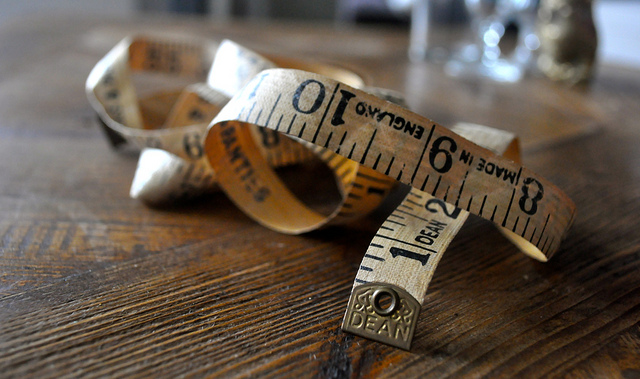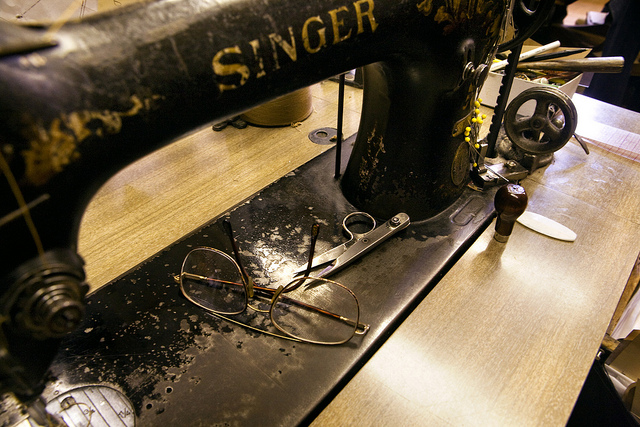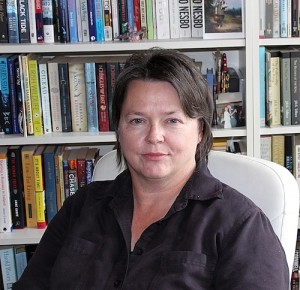
There are historically three major styles of [men’s] suits. The first is the English style, typified by soft, unpadded shoulders, a long, hourglass body with a high waist, either double or single breasted, with two or three buttons or side vents. The next is the Italian or Continental style, epitomized by a lightweight construction, squared and high shoulders, a short close-fitting single-breasted body, with two buttons and no vent. Rounding out the group is the American Sack Suit, a natural-shoulder suit with a straight and somewhat roomier body, two or three buttons, and a back vent.
My father was a tailor. He learnt his trade in a tailoring workroom where men’s suits were custom-made. Over the years, the workroom morphed into a factory as demand for custom-made suits fell and demand for off-the- rack suits grew. My father was pained by this slippage of standards in men’s clothing. He sighed when he saw men wearing suits whose sleeves were fractionally short or whose trousers were fractionally long. He couldn’t bear cheap fabrics that creased or pilled or looked old before their time.
The man who takes care with proportion in his suits . . . always looks good [but] a poorly fitting suit will never look right on the wearer, regardless of the quality or detailing.
To keep up with demand for off-the-rack suits, “piecework” was introduced to my father’s workroom. Suits were made by machinists in an assembly-line, sleeves at one workstation, collars at another. More and more suits were made, more and more efficiently. (A team of Swedish experts had arrived one summer in the early seventies and swept through the workroom with clipboards and checklists. Their ‘time and motion’ study was a source of bitter amusement to my father, who saw the logic of assembly line tailoring but regretted the downgrading of skills it promoted.)
In time, my father became the manager of the factory. He spent the bulk of his days trying to fend off the challenge of an increasingly casual dress code and the importing of cheap, mass-produced suits from the Far East.
But at night! At night, my father made suits the old-fashioned way.
Bespoke suits are custom-tailored to a gentleman’s measurements and built by hand by a master tailor; a custom pattern is created for each man, kept on record and pulled out only when small alterations or new garments are made.
He had a succession of private clients that he fitted out for job interviews and weddings, TV appearances and funerals. These ‘gentlemen callers’ were a colourful presence in our lives, arriving in the evenings to try on suits in various stages of completion. My father would lead them to the hall mirror to examine their reflection while he chalked up minor adjustments – a button to be moved here, a pocket to be dropped there.
My father knew his clients’ bodies intimately. He knew whose shoulders sloped, who had one leg longer than the other, and whose neck was disproportionately large. He understood imperfection, and used his craft to minimise it.
A good tailor will cut a suit to flatter the wearer’s strengths and hide his weaknesses. For this reason alone a man should consider custom clothing.
His workroom at home was a converted box room. He had a large work bench on which he laid out his patterns and cloth and most nights he’d sit on this workbench, legs crossed, sewing by hand. He had a sewing machine, an old Singer at first, later a more industrial cast-off from the factory, and our evenings were punctuated by their intermittent thrum. But mostly, he sewed by hand, row after row of neat stitches, invisible to all but the most intense scrutiny. (I learned later that at least fifty hours of hand labour goes into a bespoke suit. Each suit comprises two hundred and twenty components; ten to thirty-five measurements; and five to six yards of fabric.)
An indicator of quality is the suit’s trimming and overall style; it’s the selection of details which give a suit its ultimate distinctiveness. Options on a man’s suit include pocket styles, linings, button materials, and the addition of subtle signals of the suit’s quality such as ticket pockets and functional sleeve buttons, also called surgeon’s cuffs.
The workroom was filled with the tools of tailoring: measuring tapes that my father wore slung around his neck, tailor’s chalk, thimbles of assorted sizes, needles, thread (machine thread and thread for hand sewing), a collection of scissors and tailoring shears, buttons, bolts of fabric, lining, and, of course, patterns. My father’s patterns were different from the ones my mother used in dressmaking. My mother’s patterns were gossamer-like, made from tissue paper that billowed off the table whenever the door was opened. But my father’s patterns were large and made from cardboard. They hung from a line in the workroom like target practice at a shooting range.
For centuries now, most men’s suits have been made out of wool. This trusty textile drapes beautifully, maintains its form reliably, and can be spun (from raw fibre into yarn) and woven (from yarn into fabric) to be lightweight and breathable, or to be warm and cosy.
Several times a year, my father would bring home books of fabric samples from cloth merchants like Magee and Scabal of Savile Row. These leather-bound books contained swatch after swatch of fabrics, grouped by colour and pattern and quality. My father would call us over while he flicked through the book, passing over numerous variations of plain blacks and greys and browns, passing over the pinstripes and tweeds and checks until he’d find the cloth he was looking for. Then he’d take the sample between his thumb and forefinger and rub it gently. “Feel that,” he’d say, sighing with pleasure. “Feel that.”
Made-to-measure suits are off-the-rack suits that have been fitted and altered to the wearer’s frame, made from a combination of various pre-built parts . . . They do not naturally fit a man without extensive tailoring; and even here, it is a compromise.

When I was about thirteen, my father converted his workroom into a bedroom for my grandmother and moved his workroom into the garden shed. Shortly afterwards, I inherited the bedroom and my father had one of his customers, a shy, red-haired carpenter, build a desk for me. I studied at that desk throughout all of secondary school and much of college, spreading books and papers on its surface, rearranging the order of essay pages; trimming a paragraph here, adding another there.
The proportions of a man’s jacket are essential in yielding a natural, attractive visage. Whatever your size, your jacket’s length should be such that it ends at your thumb’s knuckle when you stand with your arms relaxed at your sides, and the ends of your sleeves should line up with the ends of your arms, where your hands begin.
My father rarely made women’s clothes, but occasionally, he’d make a jacket for my sisters or me. When I was in college, I desperately wanted a new jacket. I asked my father to make one, but he was busy and couldn’t find the time. A short while later, I broke up with my boyfriend and plummeted into heartbreak. My father looked at me in alarm and rushed out to his workroom, returning two days later with my new camel-coloured, satin-lined jacket. I wore that jacket all over Dublin, crying into its sleeves. It kept me company as I shuffled through Trinity College or sniffled at the bus stop. It was the warmest jacket I’ve ever had.
Men’s dress trousers should not be the focal point of a man’s attire; rather, their job is to draw the eye upward to your jacket or downward to your shoes, perhaps subtly flattering your legs. Trouser cuffs . . . should rest against the back of a man’s shoe and drape just on top of the front of the shoe: a slightly-pointed ‘beak’ where the pressed fold of the trouser rests on the shoe is a sign of a good fit.
When I was getting married, I refused to allow my father to make my husband’s wedding suit and insisted on hiring one instead. I wanted to assert my independence, I suppose, and chose to do so in a way calculated to hurt. My father was horrified. He responded by making himself two suits for the wedding, one to wear to the church, and one to wear to the reception.
The night before the wedding, my fiancé tried on his hired wedding suit. The jacket was fine, but the trousers were about a foot too short. My father exploded in a fury of arm waving and expletives, assuring me that this would never have happened if I’d let him make the suit.
My fiancé bent his knees, tried to shrink his frame to fit the trousers.
The path to elegance begins with the suit, the cornerstone of men’s fashion.
My father and I were polar opposites. He was a busy man, who hated to sit; I loved to sit and hated to be busy. We rarely spoke about anything of significance. He was impossible to get to know.
His great passion in life was golf. He loved his golf club and suggested I have my wedding reception there. For once, I was happy to accede, grateful for a venue close to the city yet surrounded by trees.
After he died, I found a video tape of me leaving the reception with my new husband. The guests are clapping and singing and I toss my bouquet over my shoulder and skip down the steps to the waiting car. The camera follows the car as it makes its way down the drive, then pans back to the cheering crowd. My father stands in the middle of the crowd, wearing his second suit, sobbing.
The truth of the matter is that there are as many styles [of suits] as there are men; within each of us is our own personal style, in part dictated by our physical characteristics but more importantly determined by how we see ourselves.
My new husband and I emigrated to America. The following year, my father came to visit. He stepped off the plane wearing a suit, but soon bowed to the relentless heat and humidity of the Midwest. He began to wear cargo shorts with silk dress shirts and dark socks. His white legs contrasted with his weather-beaten face and the rich tan that ran from his elbows to his wrist.
It was disconcerting to see my father’s dress sense desert him. He was a beautiful dresser on formal occasions, and had a range of suits and sports coats in classic colours and weights.
But the dichotomy in his wardrobe reflected a dichotomy in his public and private persona. In public, he was garrulous and sociable, a raconteur and bon vivant. At home, he was often private and withdrawn. He kept busy in the garden and in his workroom, read the paper and watched the news. He was not a man to sit and talk, not a man to enquire about your feelings or discuss his own.
Assuming equality of cut, a custom-made or bespoke suit will flatter more than a made-to-measure suit, which in turn will have a better fit than an off the rack suit.
The first time my father visited our apartment, I showed him the curtains I’d made by cutting a width of fabric in half, draping each half over a curtain pole, pulling the top of the fabric into rosettes, and securing the whole creation with elastic bands. The ‘curtains’ didn’t close and were unlined and unhemmed, but I thought they looked good and was proud of my ten-minute, no-sew decorating fix. My father was perplexed when he saw the curtains. He puzzled over them for a long time, turning the fabric one way, then another. He looked up at the elastic bands and down at the raw edges of cloth pooling on the floor. But he never said a word.
A few years later, my husband and I bought a house, and my father again came to visit. I’d kept the curtain fabric from the old apartment, hoping to reuse it in the new house. My father measured the window in the living room and shook his head. “There’s not enough,” he said.
Still, he laid the two strips of fabric on the ground and walked around them, looking to see if he could reconfigure the cloth by cutting and joining pieces. Then he rolled up his sleeves and began the process of making a pair of curtains, fully lined, fully hemmed, and fully functional.
There are few events at which a man in a good-looking suit will be out of place, particularly if the man has a firm grasp of fashion and an understanding of his personal style.
Neither of my brothers was interested in suits, preferring to dress more casually. If my father was disappointed, he never said so.
My own son is sixteen now. His wardrobe consists of tee shirts and jeans, but lately he’s been extolling the virtues of a suit. “A black suit would look great,” he tells me. “With a black tie and a waistcoat.”
My daughter once asked if I’d kept any of the clothes I wore when I was younger. She was going through a ‘vintage’ stage, and wanted to refashion old clothes, but the only piece of clothing I’ve ever kept was a skirt my father had made for me when I first started to work. It’s a straight skirt, cut from black and white herringbone tweed, tailored to fit perfectly at the waist and hips (just two small darts at the front). It hangs mid-calf, longer than today’s business skirts. A three-inch slit in the back reveals flashes of satin lining in an unexpected maroon colour.
I loved wearing that skirt, and even though it will never fit me again, I refuse to allow my daughter to cut it up. It hangs on a wooden hanger in my wardrobe instead (wire hangers cause clothes to crease), dry-cleaned, ironed.
The most timeless suit lapels are of a moderate width and are matched to the proportions of the wearer. The vast majority of lapels fall into two styles: notched, which has a wide V-shaped opening where the lapel and collar join; and peaked, which flares out in a sharp point with a very narrow deep V at the join, creating the illusion of slimness and height.
Before he died, my father chose which suit he wanted to be buried in. At the funeral home, my sister leaned into his coffin and straightened his lapel. Later, she asked me if I’d write his eulogy. But I couldn’t see the pattern in his life, the craft.
 Aileen Hunt is an Irish writer with a particular interest in creative nonfiction. Her work has appeared in the Lindenwood Review and Compose: A Journal of Simply Good Writing. Additional essays are forthcoming from Creative Nonfiction and the Eastern Iowa Review. Aileen is working on a collection of flash nonfiction essays based on the lives of pioneering women. You can find her at www.aileen-hunt.com where she blogs regularly about the strange and unexpected things that catch her attention.
Aileen Hunt is an Irish writer with a particular interest in creative nonfiction. Her work has appeared in the Lindenwood Review and Compose: A Journal of Simply Good Writing. Additional essays are forthcoming from Creative Nonfiction and the Eastern Iowa Review. Aileen is working on a collection of flash nonfiction essays based on the lives of pioneering women. You can find her at www.aileen-hunt.com where she blogs regularly about the strange and unexpected things that catch her attention.
IMAGE CREDIT: Ciara McDonnell/Flickr Creative Commons
ACKNOWLEDGMENT: Tailoring how-to excerpts from ATailoredSuit.com.



Thank you for this glimpse on your father. Of interest was your feeling that you did not know him, because I felt I understood him quite well upon reading this piece. But then, clearly he was an introvert and so am I. I was charmed by his dedication to his art and his work ethic. The camel coat he made you — how happy it must have made him to see how you loved it. I also enjoyed the way you wove the information about tailoring throughout the essay. This is a great piece of writing and I enjoyed it very much.
Many thanks, Jayne. I suppose one of the benefits (or sorrows) of getting older is a growing appreciation of the complexities of other people. So many things make sense in retrospect. I’m glad you enjoyed this piece. Thanks for reading!
Retrospect… Yes. I’m learning this myself.
🙂 Maybe we’re all getting wiser….
God, I hope so. Or this getting older business would really suck.
As someone with a parent who also was an accomplished, European seamstress, this piece wholly resonated with me–the connection of craft and style to the structure of a parent’s personality and outlook. This is a memorable one for me.
Thanks Pamela. I wish I’d inherited some of my dad’s talent with a needle, but I’m useless in that department. I still appreciate a good suit, though!
I was sadly lacking in this department as well. Perhaps that sort of finesse skips a generation?
Eileen, this is a beautiful, delicious biography. Congratulations
Thanks so much, Marlena. Glad you enjoyed it.
I just love, love this essay Aileen! Brava!
Thank you, Cathy. I enjoyed writing this piece. It had been on my mind for a long time, so I was happy to find a structure that worked. All the best!